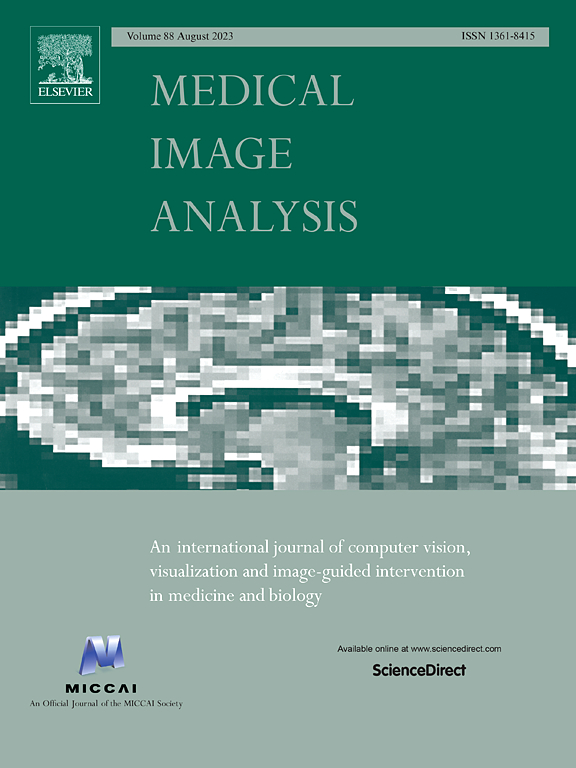上半身自由呼吸磁共振指纹技术应用于水T1和脂肪分数的定量
IF 10.7
1区 医学
Q1 COMPUTER SCIENCE, ARTIFICIAL INTELLIGENCE
引用次数: 0
摘要
在过去的十年中,磁共振指纹(MRF)已经成为一种快速、同时量化多种MRI参数的有效范例,包括脂肪分数(FF)、水T1 (T1H2O)、水T2 (T2H2O)和脂肪T1 (T1fat)。这些参数作为有前途的成像生物标志物在各种解剖目标,如心脏,肝脏和骨骼肌。然而,由于生理运动,特别是呼吸运动,在上半身测量这些参数带来了挑战。在这项工作中,我们提出了一种新的方法,即运动校正(MoCo) MRF T1-FF,该方法使用优化的初步运动扫描来估计运动场,并在字典搜索之前使用它来校正MRF采集数据,以重建上半身区域的运动校正FF和T1H2O参数图。我们使用体内数据集验证了该框架,该数据集包括18名健康志愿者(12名男性,6名女性,平均年龄= 40±14岁)和3名患有不同神经肌肉疾病的受试者。在ROI水平上,在受运动影响最小的区域,FF和T1H2O (- 5.5 ms)值的未校正和MoCo重建之间没有明显的偏差(平均差值为-0.6%)。此外,MoCo MRF T1-FF显著降低了这些区域评估分布的标准差,表明精度提高。值得注意的是,在受运动严重影响的区域,如呼吸肌、肝脏和肾脏,在运动校正后,MRF参数图显示出运动模糊和条纹伪影的显著减少。此外,在运动校正后,在参数图上始终可以看到隔膜。该方法为目前研究较少的区域,如呼吸肌,尤其是肋间肌和膈肌,FF和T1H2O的联合三维量化奠定了基础。本文章由计算机程序翻译,如有差异,请以英文原文为准。

Upper-body free-breathing Magnetic Resonance Fingerprinting applied to the quantification of water T1 and fat fraction
Over the past decade, Magnetic Resonance Fingerprinting (MRF) has emerged as an efficient paradigm for the rapid and simultaneous quantification of multiple MRI parameters, including fat fraction (FF), water T1 (), water T2 (), and fat T1 (). These parameters serve as promising imaging biomarkers in various anatomical targets such as the heart, liver, and skeletal muscles. However, measuring these parameters in the upper body poses challenges due to physiological motion, particularly respiratory motion. In this work, we propose a novel approach, motion-corrected (MoCo) MRF T1-FF, which estimates the motion field using an optimized preliminary motion scan and uses it to correct the MRF acquisition data before dictionary search for reconstructing motion-corrected FF and parametric maps of the upper-body region. We validated this framework using an in vivo dataset comprising 18 healthy volunteers (12 men, 6 women, mean age = 40 ± 14 years old) and a 3 subjects with different neuromuscular disorders. At the ROI level, in regions minimally affected by motion, no significant bias was observed between the uncorrected and MoCo reconstructions for FF (mean difference of -0.6%) and ( ms) values. Moreover, MoCo MRF T1-FF significantly reduced the standard deviations of distributions assessed in these regions, indicating improved precision. Notably, in regions heavily affected by motion, such as respiratory muscles, liver, and kidneys, the MRF parametric maps exhibited a marked reduction in motion blurring and streaking artifacts after motion correction. Furthermore, the diaphragm was consistently discernible on parametric maps after motion correction. This approach lays the groundwork for the joint 3D quantification of FF and in regions that are rarely studied, such as the respiratory muscles, particularly the intercostal muscles and diaphragm.
求助全文
通过发布文献求助,成功后即可免费获取论文全文。
去求助
来源期刊

Medical image analysis
工程技术-工程:生物医学
CiteScore
22.10
自引率
6.40%
发文量
309
审稿时长
6.6 months
期刊介绍:
Medical Image Analysis serves as a platform for sharing new research findings in the realm of medical and biological image analysis, with a focus on applications of computer vision, virtual reality, and robotics to biomedical imaging challenges. The journal prioritizes the publication of high-quality, original papers contributing to the fundamental science of processing, analyzing, and utilizing medical and biological images. It welcomes approaches utilizing biomedical image datasets across all spatial scales, from molecular/cellular imaging to tissue/organ imaging.
 求助内容:
求助内容: 应助结果提醒方式:
应助结果提醒方式:


